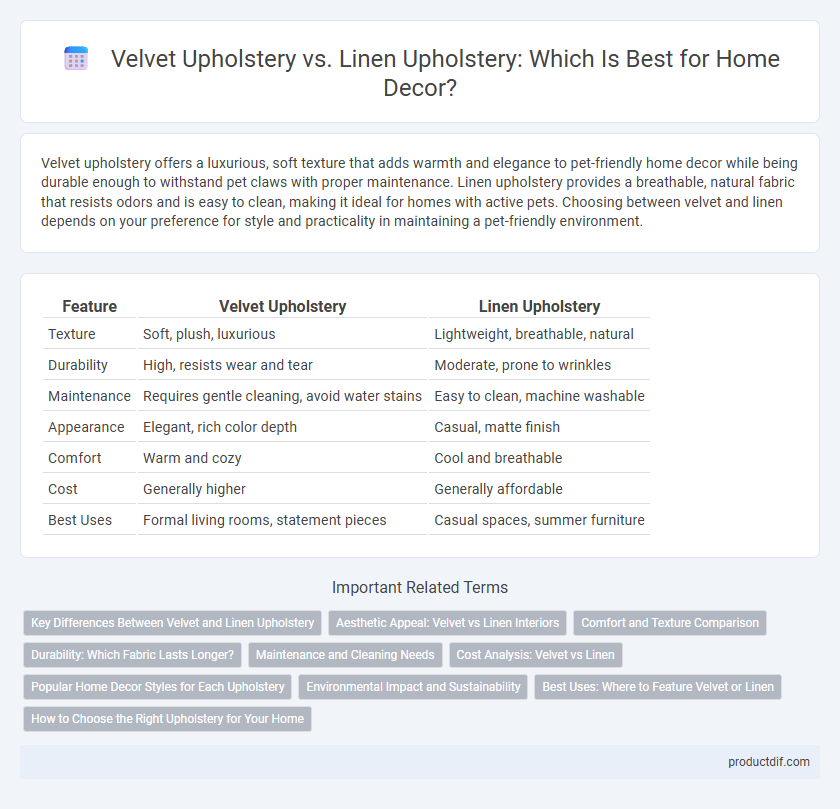Velvet upholstery offers a luxurious, soft texture that adds warmth and elegance to pet-friendly home decor while being durable enough to withstand pet claws with proper maintenance. Linen upholstery provides a breathable, natural fabric that resists odors and is easy to clean, making it ideal for homes with active pets. Choosing between velvet and linen depends on your preference for style and practicality in maintaining a pet-friendly environment.
Table of Comparison
| Feature | Velvet Upholstery | Linen Upholstery |
|---|---|---|
| Texture | Soft, plush, luxurious | Lightweight, breathable, natural |
| Durability | High, resists wear and tear | Moderate, prone to wrinkles |
| Maintenance | Requires gentle cleaning, avoid water stains | Easy to clean, machine washable |
| Appearance | Elegant, rich color depth | Casual, matte finish |
| Comfort | Warm and cozy | Cool and breathable |
| Cost | Generally higher | Generally affordable |
| Best Uses | Formal living rooms, statement pieces | Casual spaces, summer furniture |
Key Differences Between Velvet and Linen Upholstery
Velvet upholstery offers a luxurious, soft texture with a rich sheen, making it ideal for creating a cozy and elegant ambiance, while linen upholstery provides a breathable, durable fabric known for its natural, matte finish and casual sophistication. Velvet's dense pile makes it more resistant to wear but requires careful maintenance to prevent crushing, whereas linen is more prone to wrinkling but excels in moisture-wicking and temperature regulation. The choice between velvet and linen upholstery ultimately depends on desired aesthetics, durability, and ease of care in home decor applications.
Aesthetic Appeal: Velvet vs Linen Interiors
Velvet upholstery exudes a luxurious, rich texture with a subtle sheen, creating an opulent and cozy ambiance ideal for classic or glamorous interiors. Linen upholstery offers a natural, breathable fabric with a matte finish, perfect for casual, airy, and minimalist designs, giving spaces a relaxed yet sophisticated look. Choosing between velvet and linen hinges on the desired aesthetic: velvet elevates elegance and warmth, while linen emphasizes simplicity and understated charm.
Comfort and Texture Comparison
Velvet upholstery offers a plush, soft texture that provides exceptional comfort through its dense, smooth pile, making it ideal for cozy, luxurious seating. Linen upholstery features a lighter, breathable fabric with a slightly crisp texture, promoting comfort in warmer climates due to its moisture-wicking and cooling properties. The choice between velvet and linen upholstery centers on preference for velvet's velvety softness versus linen's natural, airy feel and durability.
Durability: Which Fabric Lasts Longer?
Velvet upholstery offers exceptional durability due to its dense weave and plush texture, making it highly resistant to wear and tear in high-traffic areas. Linen upholstery, while breathable and lightweight, tends to be less durable, showing signs of wear more quickly and being prone to wrinkling and staining over time. For long-lasting furniture, velvet outperforms linen by maintaining its appearance and structural integrity under frequent use.
Maintenance and Cleaning Needs
Velvet upholstery requires delicate maintenance with regular vacuuming and gentle spot cleaning to preserve its rich texture and prevent crushing, while linen upholstery demands frequent laundering due to its natural tendency to attract dust and stains but offers better breathability. Velvet is more prone to water spots and requires specialized cleaning products, whereas linen can withstand harsher cleaning methods but wrinkles easily, necessitating occasional ironing or steaming. Both materials benefit from professional cleaning every 12 to 18 months to maintain their appearance and longevity.
Cost Analysis: Velvet vs Linen
Velvet upholstery typically costs more than linen due to its luxurious texture and complex manufacturing process, averaging between $50 to $120 per yard compared to linen's $30 to $80 per yard. Maintenance and durability also affect long-term expenses, as velvet requires specialized cleaning and may show wear faster, increasing upkeep costs. Linen's affordability and natural fiber composition make it a budget-friendly option with easier maintenance and higher resistance to fading and pilling.
Popular Home Decor Styles for Each Upholstery
Velvet upholstery is favored in luxurious and vintage-inspired home decor styles like Victorian, Art Deco, and modern glam, offering rich texture and a soft, opulent feel. Linen upholstery complements minimalist, Scandinavian, and coastal styles, providing a light, breathable fabric that enhances natural, airy aesthetics. Both materials cater to distinct decor preferences, with velvet evoking warmth and sophistication, while linen supports casual, organic, and eco-friendly interiors.
Environmental Impact and Sustainability
Velvet upholstery, often made from synthetic fibers, has a higher environmental footprint due to energy-intensive production and less biodegradability compared to linen upholstery, which is derived from flax plants and is fully biodegradable. Linen's cultivation requires fewer pesticides and less water, making it a more sustainable choice for eco-conscious home decor. Choosing linen upholstery supports renewable resources and reduces long-term waste in interior design.
Best Uses: Where to Feature Velvet or Linen
Velvet upholstery excels in formal living rooms and bedrooms where its luxurious texture and rich colors create an opulent atmosphere. Linen upholstery suits casual spaces such as sunrooms and coastal-style lounges due to its breathable, lightweight fabric and natural appearance. For high-traffic areas, linen's durability and easy maintenance make it preferable over velvet's more delicate surface.
How to Choose the Right Upholstery for Your Home
Velvet upholstery offers a luxurious, soft texture and rich color depth that suits formal living spaces and adds warmth, while linen upholstery provides a breathable, natural fabric ideal for casual, airy rooms with a relaxed vibe. Choose velvet for durability in low-traffic areas where elegance is prioritized, and opt for linen in high-traffic zones due to its resistance to wear and easy maintenance. Consider your lifestyle, room function, and desired ambiance to select upholstery that balances comfort, style, and practicality.
Velvet Upholstery vs Linen Upholstery Infographic

 productdif.com
productdif.com